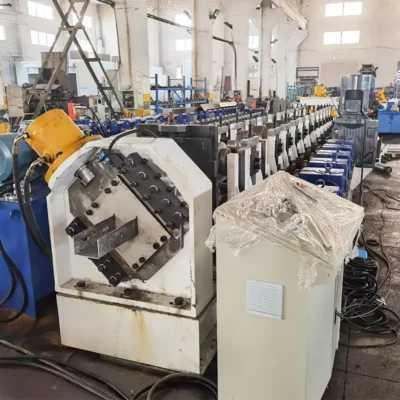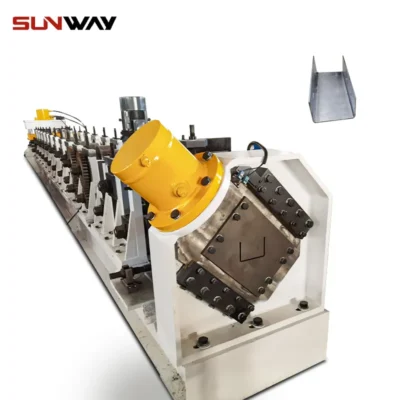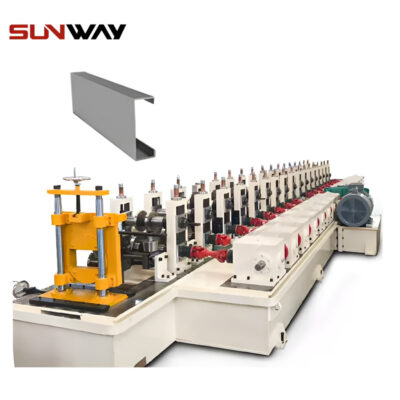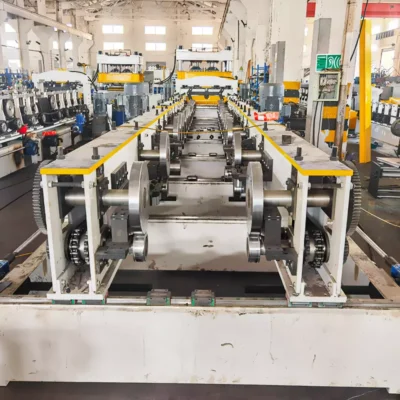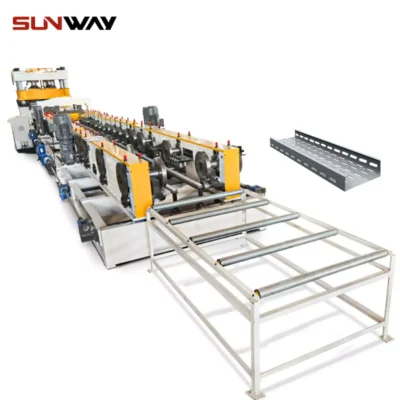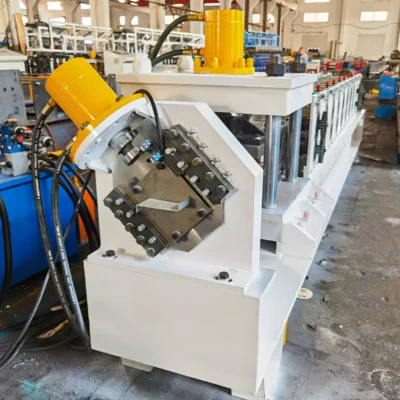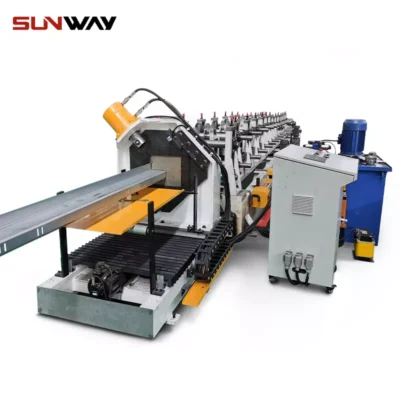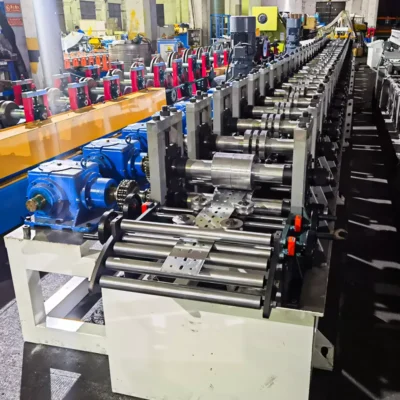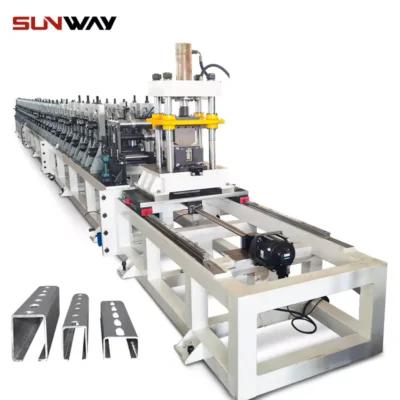If you’ve ever marveled at the sleek design of a smartphone, the compact form of a laptop, or the intricate circuitry of a modern device, it’s easy to overlook the critical components holding these technological marvels together. Behind the scenes, Electronic Component Roll Forming Machines play a pivotal role in manufacturing the precise metal frames, connectors, and housing required in the electronics industry.
This article will explore what electronic component roll forming machines are, their applications, cutting-edge features, pricing, market trends, troubleshooting tips, and why Wuxi Sunway Machinery is a global leader in this space. Whether you’re an electronics manufacturer or a business looking to upgrade your production line, this guide will provide all the insights you need to stay ahead of the curve.
What Are Electronic Component Roll Forming Machines?
An Electronic Component Roll Forming Machine is specialized industrial equipment designed to process raw metal materials, such as aluminum or steel, into highly precise and intricate profiles used in electronic devices. These machines are essential for producing metal frames, brackets, connectors, shielding covers, and other structural electronic components.
Key Features
- High Precision: Ensures dimensional accuracy to meet the tight tolerances required in electronics manufacturing.
- Material Diversity: Processes lightweight and conductive metals such as aluminum, copper, and stainless steel.
- Custom Profiles: Supports the production of intricate profiles tailored to specific electronic applications.
- Automated Production: Enables large-scale manufacturing with consistent quality.
- Eco-Friendly Operations: Minimizes material waste and supports sustainable production practices.
Applications of Electronic Component Roll Forming Machines
Electronic components are fundamental to the functionality and durability of a wide range of devices. Here’s where Electronic Component Roll Forming Machines make a significant impact:
1. Consumer Electronics
- Use Case: Producing metal frames and structural components for smartphones, tablets, and laptops.
- Why It’s Essential: Ensures lightweight, durable, and precise components for sleek electronic designs.
2. Automotive Electronics
- Use Case: Manufacturing connectors, clips, and brackets for in-vehicle infotainment systems and sensors.
- Why It’s Critical: Provides the durability and precision needed for harsh automotive environments.
3. Telecommunications
- Use Case: Crafting shielding covers and connectors for telecommunications equipment.
- Why It’s Beneficial: Enhances signal integrity and protects sensitive components from electromagnetic interference.
4. Medical Devices
- Use Case: Producing structural components and casings for medical electronics like diagnostic equipment.
- Why It’s Necessary: Combines precision and safety for life-saving applications.
5. Industrial Electronics
- Use Case: Manufacturing enclosures, cooling fins, and heat sinks for industrial control systems.
- Why It’s Relevant: Supports robust designs capable of withstanding extreme operating conditions.
6. Renewable Energy Systems
- Use Case: Producing connectors and frames for photovoltaic panels and wind turbine electronics.
- Why It’s Unique: Ensures the reliability and efficiency of renewable energy systems.
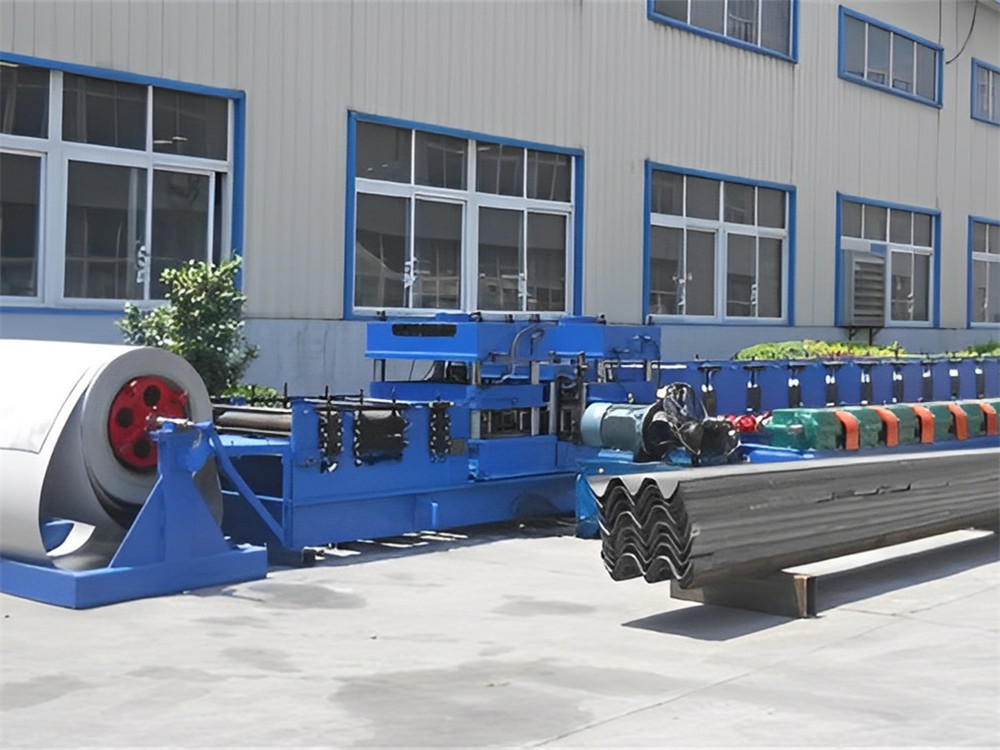
Why Electronic Component Roll Forming Machines Are Indispensable
The demand for miniaturized, precise, and durable electronic components is growing rapidly across industries. Here’s why Electronic Component Roll Forming Machines are critical to meeting this demand:
1. High Precision for Complex Designs
- Why It’s Necessary: Roll-forming machines achieve the tight tolerances required for intricate electronic components, ensuring seamless integration.
2. Lightweight Components
- Why It’s Beneficial: Supports the production of lightweight metal profiles, reducing the overall weight of electronic devices.
3. High-Volume Production
- Why It’s Essential: Automated systems enable manufacturers to meet the growing demand for electronic components efficiently.
4. Cost Efficiency
- Why It’s Practical: Reduces manufacturing costs through material optimization and high-speed production.
5. Sustainability
- Why It’s Relevant: Machines are designed to minimize waste and support the use of recyclable materials, aligning with global sustainability goals.
Key Features of Wuxi Sunway Electronic Component Roll Forming Machines
Wuxi Sunway Machinery offers state-of-the-art roll-forming technology tailored to the needs of electronic component manufacturers. Here’s why their machines are the preferred choice:
1. Advanced Material Handling
- Supported Materials:
- Aluminum
- Copper
- Stainless Steel
- Galvanized Steel
- Why It’s Beneficial: Ensures compatibility with the lightweight, conductive, and corrosion-resistant materials used in electronics.
2. Ultra-High Precision
- Performance: Maintains tolerances as low as ±0.01mm, meeting the stringent requirements of the electronics industry.
- Why It’s Important: Guarantees flawless component integration and functionality.
3. Modular Tooling Systems
- What It Offers: Interchangeable tooling for producing multiple profiles on a single machine.
- Why It’s Versatile: Supports diverse electronic designs without requiring additional equipment.
4. Integrated Cutting and Punching
- What It Includes: Built-in systems for precision cutting, punching, and notching during the roll-forming process.
- Why It’s Efficient: Reduces production time and ensures ready-to-install components.
5. IoT and Automation Integration
- What It Enables: Real-time monitoring, automated adjustments, and predictive maintenance using IoT systems.
- Why It’s Revolutionary:
- Enhances production efficiency.
- Reduces downtime and operational costs.
6. Eco-Friendly Design
- What It Includes: Energy-efficient motors, optimized workflows, and waste reduction systems.
- Why It’s Sustainable: Aligns with global sustainability goals and supports eco-friendly manufacturing.
Pricing of Electronic Component Roll Forming Machines
The cost of an Electronic Component Roll Forming Machine depends on its features, capacity, and level of customization. Below is a general pricing guide for 2025:
| Machine Type | Capabilities | Price Range (USD) |
|---|---|---|
| Standard Machines | Basic component production | 150,000–150,000–150,000–400,000 |
| Advanced Machines | High-speed, integrated cutting and punching systems | 400,000–400,000–400,000–1,200,000 |
| Fully Customizable Machines | IoT, modular tooling, and eco-friendly features | 1,200,000–1,200,000–1,200,000–3,000,000 |
For detailed pricing and consultation, contact Wuxi Sunway Machinery.
Global Market Trends for Electronic Component Roll Forming Machines in 2025
The electronics industry is evolving rapidly, driven by technological advancements and increasing consumer demand. Here are the key trends shaping the market:
1. Miniaturization of Electronics
- Trend: Devices are becoming smaller and more compact, requiring precise and intricate components.
- Impact: Demand for ultra-high-precision roll-forming machines is on the rise.
2. Growth in Electric Vehicles (EVs)
- Trend: The rise of EVs is driving demand for electronic components like connectors and cooling systems.
- Impact: Machines capable of producing lightweight and durable components are in high demand.
3. Sustainability Mandates
- Trend: Companies are adopting eco-friendly practices to meet consumer expectations and regulatory requirements.
- Impact: Roll-forming machines designed for recyclable materials are becoming industry standards.
4. Integration with Industry 4.0
- Trend: The adoption of IoT and AI in manufacturing is enhancing production efficiency.
- Impact: Smart roll-forming machines with real-time monitoring are now essential.
5. Expansion of 5G Infrastructure
- Trend: The rollout of 5G networks is increasing demand for shielding covers and connectors.
- Impact: High-capacity machines are required to meet production demands.
FAQs About Electronic Component Roll Forming Machines
| Question | Answer |
|---|---|
| What materials can these machines process? | Aluminum, copper, stainless steel, and galvanized steel. |
| What is the production speed? | Up to 60–120 meters per minute, depending on material and profile complexity. |
| Are these machines eco-friendly? | Yes, they include energy-efficient motors and minimize material waste. |
| Can these machines handle custom designs? | Absolutely! Modular tooling supports bespoke profiles for diverse electronic applications. |
| What is the price range for these machines? | Prices range from 150,000to150,000 to 150,000to3,000,000, based on features and customization. |
| Do these machines integrate with IoT systems? | Yes, IoT-enabled features allow real-time monitoring and predictive maintenance. |
Troubleshooting Common Issues in Electronic Component Roll Forming Machines
While Electronic Component Roll Forming Machines are built for high reliability, occasional issues can arise, especially in high-capacity production environments. Here’s how to quickly identify and resolve common problems:
1. Dimensional Inaccuracies
- Symptoms: Components do not meet specified size tolerances or exhibit uneven edges.
- Possible Causes:
- Misalignment of rollers.
- Worn-out tooling or dies.
- Solution:
- Regularly inspect and recalibrate the rollers.
- Replace worn tooling to maintain precision.
2. Material Jamming
- Symptoms: Material fails to pass through the machine smoothly, causing production halts.
- Possible Causes:
- Material thickness exceeding machine capacity.
- Foreign debris lodged in the rollers or guides.
- Solution:
- Ensure raw materials meet the machine’s specifications.
- Clean guides and rollers regularly to prevent buildup.
3. Uneven Cutting or Punching
- Symptoms: Finished components exhibit incomplete or inaccurate cuts and holes.
- Possible Causes:
- Dull cutting or punching tools.
- Misaligned cutting and punching mechanisms.
- Solution:
- Sharpen or replace cutting and punching tools as needed.
- Realign mechanisms to ensure proper operation.
4. Electrical or Software Malfunctions
- Symptoms: The machine unexpectedly shuts down, or sensors fail to respond.
- Possible Causes:
- Loose wiring connections.
- Outdated control software.
- Solution:
- Inspect and secure wiring connections.
- Update the machine’s software to the latest version.
5. Vibration or Noise During Operation
- Symptoms: Excessive vibrations or unusual noises during production.
- Possible Causes:
- Loose components or misaligned parts.
- Roller wear and tear.
- Solution:
- Tighten all components and check for proper alignment.
- Replace worn rollers to ensure smooth operation.
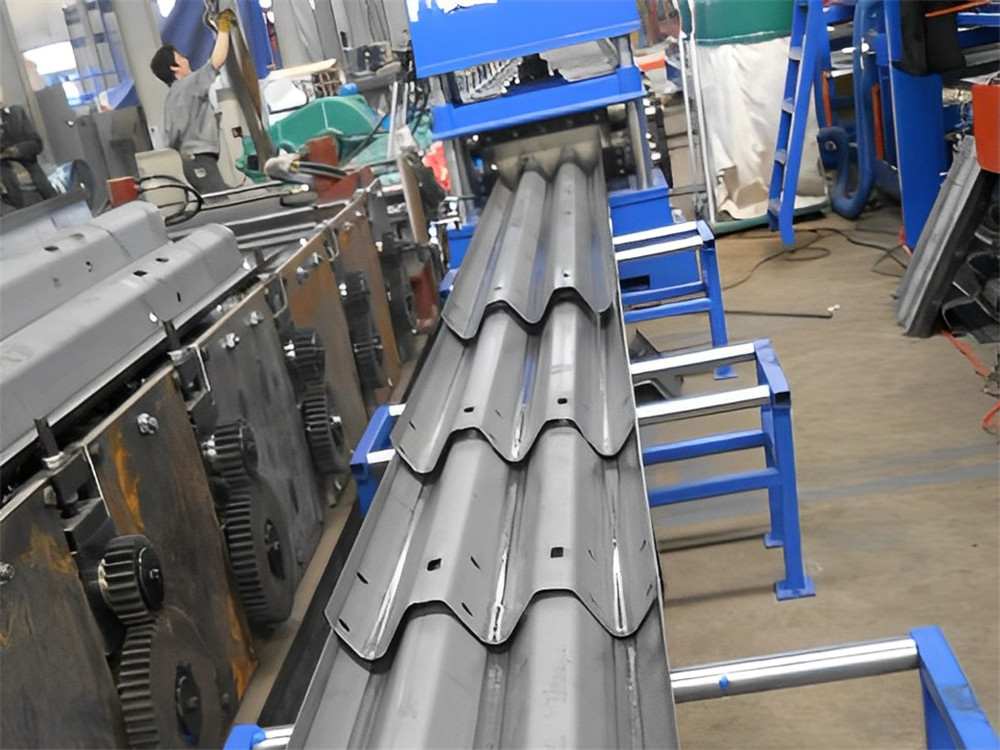
Safety Features of Electronic Component Roll Forming Machines
Safety is non-negotiable in electronics manufacturing, and Electronic Component Roll Forming Machines are equipped with advanced features to protect operators and ensure compliance with global safety standards.
1. Emergency Stop Systems
- What It Does: Allows operators to immediately halt machine operations in emergencies.
- Why It’s Critical: Prevents accidents and minimizes potential damage to the machine.
2. Safety Shields
- What It Includes: Transparent shields around moving parts to prevent accidental contact.
- Why It’s Important: Reduces the risk of injuries caused by human error.
3. Light Curtains
- What It Detects: Identifies objects or personnel in restricted zones and stops the machine automatically.
- Why It’s Effective: Enhances safety while maintaining production efficiency.
4. Noise and Vibration Dampening
- What It Reduces: Minimizes operational noise and vibrations.
- Why It’s Beneficial: Creates a safer and more comfortable working environment.
5. Compliance with Safety Standards
- Certifications: Machines meet CE, ISO 45001, and OSHA standards.
- Why It’s Necessary: Ensures safe operation across diverse global markets.
Automation in Electronic Component Roll Forming Machines
Automation has become a cornerstone of modern manufacturing, and Electronic Component Roll Forming Machines are no exception. Below are some of the ways automation is transforming production:
1. Real-Time Monitoring
- What It Tracks: Production metrics such as output, material usage, and machine performance.
- Why It’s Valuable: Enables manufacturers to optimize processes and reduce waste.
2. Predictive Maintenance
- What It Enables: Uses IoT sensors to detect wear and tear, preventing unexpected breakdowns.
- Why It’s Revolutionary:
- Minimizes downtime.
- Extends machine lifespan.
3. Automated Adjustments
- What It Offers: Automatically adjusts rollers, cutters, and punches to accommodate different materials or profiles.
- Why It’s Efficient:
- Reduces setup time.
- Ensures consistent quality.
4. Data-Driven Decision Making
- What It Provides: Detailed reports on production performance, helping manufacturers identify areas for improvement.
- Why It’s Useful: Enables data-informed strategies for increasing productivity.
5. Integration with Industry 4.0
- What It Includes: Compatibility with IoT, AI, and machine learning systems for smart manufacturing.
- Why It’s Game-Changing:
- Enhances operational efficiency.
- Supports advanced quality control.
Real-World Success Stories: Electronic Component Roll Forming Machines in Action
The versatility and efficiency of Electronic Component Roll Forming Machines have enabled manufacturers across industries to achieve remarkable results. Here are some success stories:
1. Smartphone Manufacturer
Client: A global leader in consumer electronics.
Challenge: The company needed ultra-light, precise aluminum frames for its new smartphone model.
Solution: Wuxi Sunway provided a roll-forming machine with ±0.01mm tolerance capability and integrated surface treatment options.
Outcome:
- Produced frames with a 30% reduction in weight.
- Reduced material waste by 20%, supporting the company’s sustainability goals.
- Enabled the launch of the new model ahead of schedule.
2. Automotive Electronics Supplier
Client: A supplier of electric vehicle (EV) components.
Challenge: The client required durable connectors and brackets to withstand high temperatures and vibrations.
Solution: Wuxi Sunway supplied a machine optimized for high-tensile steel with integrated punching and welding systems.
Outcome:
- Improved product durability, reducing warranty claims by 25%.
- Increased production capacity by 40%, meeting growing EV demand.
- Enhanced brand reputation for quality and reliability.
3. Telecommunications Equipment Manufacturer
Client: A provider of 5G network infrastructure.
Challenge: The company needed shielding covers for its 5G antennas that offered high precision and electromagnetic compatibility.
Solution: Wuxi Sunway delivered a roll-forming machine with advanced cutting and coating capabilities.
Outcome:
- Produced high-quality shielding covers that met stringent performance standards.
- Reduced production time by 35%, accelerating the rollout of 5G networks.
- Strengthened the company’s competitive position in the market.
Sustainability: Environmental Benefits of Electronic Component Roll Forming Machines
In an era where sustainability is a top priority, Electronic Component Roll Forming Machines are aligned with eco-friendly manufacturing practices. Here’s how they contribute to environmental responsibility:
1. Reduced Material Waste
- How It Works: Precision cutting and forming systems minimize scrap during production.
- Impact: Conserves raw materials and reduces landfill waste.
2. Energy Efficiency
- How It’s Achieved: Advanced motors and optimized workflows reduce energy consumption.
- Impact: Lowers the carbon footprint of electronics manufacturing.
3. Support for Recyclable Materials
- What It Enables: Machines are designed to process recyclable materials like aluminum and steel.
- Impact: Promotes a circular economy and reduces resource extraction.
4. Long-Lasting Components
- Why It Matters: Durable electronic components reduce the frequency of replacements, conserving resources.
- Impact: Supports sustainable product lifecycles.
Why Wuxi Sunway Machinery Leads the Industry
Wuxi Sunway Machinery has earned its position as a global leader in roll-forming technology by consistently delivering innovative solutions tailored to the needs of modern manufacturers. Here’s why they’re the top choice for electronic component production:
- Proven Expertise: Decades of experience in designing high-performance roll-forming machines.
- Global Reach: Trusted by clients in Asia, Europe, the Americas, and more.
- Innovation-Driven: Features like IoT integration, modular tooling, and AI-powered quality control set their machines apart.
- Sustainability Commitment: Machines are optimized for energy efficiency and recyclable materials.
- Comprehensive Support: From consultation to after-sales service, Wuxi Sunway ensures a seamless experience.
FAQs About Electronic Component Roll Forming Machines
| Question | Answer |
|---|---|
| What materials can these machines process? | Aluminum, copper, stainless steel, and galvanized steel. |
| What is the production speed? | Up to 60–120 meters per minute, depending on material and profile complexity. |
| Are these machines eco-friendly? | Yes, they include energy-efficient motors and minimize material waste. |
| Can these machines handle custom designs? | Absolutely! Modular tooling supports bespoke profiles for diverse electronic applications. |
| What is the price range for these machines? | Prices range from 150,000to150,000 to 150,000to3,000,000, based on features and customization. |
| Do these machines integrate with IoT systems? | Yes, IoT-enabled features allow real-time monitoring and predictive maintenance. |
Conclusion: Shaping the Future of Electronics Manufacturing
Electronic Component Roll Forming Machines are not just tools—they are enablers of innovation, sustainability, and efficiency in the rapidly evolving electronics industry. From smartphones to EVs, these machines ensure precision and reliability in every component they produce.
Ready to revolutionize your production line? Partner with Wuxi Sunway Machinery and explore their cutting-edge roll-forming solutions designed to meet your unique needs. Together, let’s power the future of electronics—one component at a time.

